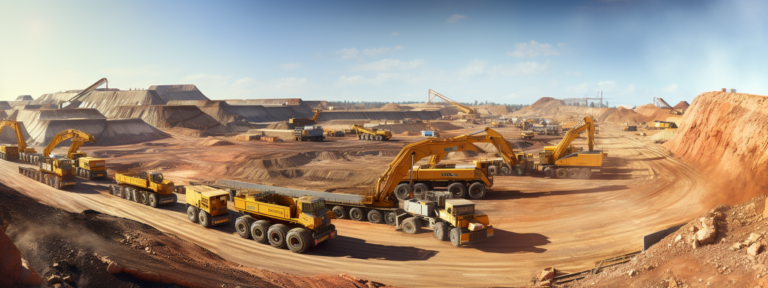The realm of global mining industry has experienced significant metamorphoses, influenced by technological evolution, regulation, climate change accountability, and evolving commodity markets among other factors.
By adopting best practices and exploring dynamic innovations, mining companies are redefining their operational landscapes.
Interdependency on global mining research and industry alignment offer a fresh vantage point for understanding the future of this much-debated sector.
Keep reading as we embark on exploring the exciting future that awaits the global mining industry, including the strategies, the consistent endeavors, and the plausible challenges ahead.
Key Takeaways on Global Mining
- The Global Mining Industry Is Undergoing Significant Changes Due to the Emphasis on Decarbonization and Digitalization.
- Technological Innovations, Such as Autonomous Systems and Digital Tools, Are Redefining Mining Operations and Improving Efficiency.
- Mining Companies Are Prioritizing Sustainability Goals, Including Reducing Carbon Emissions and Promoting Clean Energy Transition.
- Government Policies and Regulations Play a Crucial Role in Shaping the Future of the Mining Industry, Influencing Everything From Exploration to Financial Strategies.
- Climate Change Presents Challenges to Mining Operations, Leading to Disruptions and the Need for Strategic Adjustments to Sustain Growth.
Emerging Trends in Global Mining
With the ever-evolving dynamics of the global mining industry, it’s clear that mining companies are at a crucial crossroads. Rio Tinto, Glencore PLC, and BHP, some of the leading global mining companies, are adapting their mining operations and strategies to accommodate new industry alignments and climate targets.
The emphasis on decarbonization and digitalization is transforming the industry. For instance, Rio Tinto’s Pilbara iron ore mine in Australia has been using autonomous systems, signifying a significant shift towards the implementation of advanced technologies in mining operations.
Mining operations are not only about extraction and production. Interoperability, asset management, and supply chains play a significant role in determining the share price, market cap, and even the reputation of a mining company. Therefore, companies are increasingly focusing on improving these areas.
Geopolitical factors, commodity prices, and climate change impacts are influencing the decision-making processes of mining executives. As a result, companies are seeking advice from industry leaders, lawyers from notable law firms specializing in dispute resolution, and financial experts from BMO Capital Markets and BNP Paribas on navigating the complex waters of global mining.
As we delve deeper into the riveting world of modern mining trends, let’s pivot our attention towards the technological revolution shaping our tomorrow. Get ready to venture into the horizon of advancements as we explore the immense implications of these innovations on the future of mining. The Global Mining Group (GMG) is at the forefront of this transformative journey as it strives to become a leading copper producer in the minerals sector. Mining technology is the key to their success.
Implications of Technological Innovations on Future Mining
Technological innovations are redefining the future of mining, ushering in new prospects for mining operations. Autonomous systems, for instance, are optimising processes in underground mining, thereby enhancing productivity and safety. Companies like BHP and Glencore PLC are consistently harnessing these technologies to gain a competitive edge in the industry.
Another intriguing development in the industry is the advent of digitalization. Many global mining companies are turning to digital tools to improve efficiency and reduce carbon emissions. Case studies from the United Kingdom and the United States reveal successful implementation and positive impacts of digitalization in the mining sector.
The integration of technology extends beyond mine production and includes aspects like commodity trading and asset management. Top financial experts are leveraging technology to enhance operations, transactions, and client experiences.
A concerted effort towards embracing technology is also witnessed in the mining research field. Advanced tools are pivotal in global mining research, precisely analyzing metal prices, market values, and key indicators. These innovations allow mining analysts and geophysicists to predict trends and forecast potential mining activities, shaping the future of the industry.
Shaping our path forward, we must now pivot our focus towards another equally consequential facet: the mining industry’s pursuit of sustainability. Brace yourself, as we examine the ambitious sustainability goals under the microscope, aiming to redefine the landscape of extraction industries. Komatsu, porphyry, EBITDA, and others significantly influence this endeavor, involving everything from geopolitics to processing infrastructure. Additionally, the market size of lignite and the use of polygons in mining operations are important considerations.
Assessing the Sustainability Goals in Mining Industry
The global mining industry is currently grappling with the profound impacts of climate change and is therefore, making substantial efforts to align its practices with sustainability goals. The glare of public scrutiny and increasing regulations are pushing mining executives to rethink their strategies, consider de-carbonization, and commit to reduce their environmental footprint. The executive chairman plays a crucial role in driving these initiatives in the minerals sector. https://www.world-mining-data.info/
There’s a growing consensus in the mining community that meeting sustainability goals not only mitigates the environmental impact but also promises long-term economic benefits. Mining companies in the minerals sector are now prioritising the reduction of greenhouse gas emissions, waste management, and efficient use of resources. They are integrating their mining operations in ways that promote clean and efficient energy transition through mining technology:
- One notable initiative is the United Kingdom’s push towards decarbonisation, shown by Rio Tinto’s commitment to reduce carbon emissions from its operations by 2030.
- Glencore PLC is contributing to the energy transition by increasing their copper production, a critical material in electric vehicles and renewable energy infrastructures.
- United States-based firms are pioneering the use of autonomous systems in mining operation, resulting in more energy-efficient processes.
Defining the Future of Global Mining
To ensure industry alignment with sustainable practices, groups such as the Global Mining Guidelines Group (GMG) are developing best practice guidelines. These address key mining issues like waste management, underground mining safety, and water conservation. Mining technology is crucial in implementing these measures.
There’s no denying that achieving sustainability goals is a complex undertaking, fraught with numerous challenges. However, the adoption of mining technology practices signals positive change within the minerals sector, holding out the promise of a greener future for global mining.
Having examined the objectives of sustainability within the mining industry, it’s clear there’s a massive potential for change. Now, let’s pivot and explore the pivotal role government policies play in shaping the future of mining.
Role of Government Policies in Shaping Mining’s Future
Government policies worldwide play a significant role in shaping the future of the global mining industry. Regulations and guidelines stipulated by governments greatly influence decisions made by mining executives on exploration, mine production, and even commodity trading. The case of South Africa’s mining sector is a prominent example of this.
Government policies have direct and indirect impacts on various sectors of the mining industry:Policy SectorImpactEnvironmental RegulationsDirectly influence decarbonization efforts and mining operations’ practices to reduce carbon emissions.Tax PoliciesIndirectly impact commodity prices, thereby affecting profitability and financial strategies of mining companies.Royalty PoliciesAffect the financials of mining companies, thereby influencing capital markets and value as perceived by shareholders.
These policies create an environment within which mining companies, such as BHP, Glencore PLC and Rio Tinto, as well as financial institutions like BMO Capital Markets and BNP Paribas, must operate. They drive mining projects, asset management, environmental commitment, and even financial decisions.
The role of government policies in shaping the future of mining is an intricate and multi-layered issue. In the face of ever-evolving geopolitical circumstances, mining companies will need to continually adapt to ensure success in tomorrow’s industry landscape.
Now that we’ve uncovered the dynamic role of government policies in sculpting the mining industry’s future, we can’t overlook another pressing factor. Let’s plunge into the far-reaching consequences of climate change and how it’s radically transforming global mining.
Impact of Climate Change on Global Mining
Climate change presents substantial challenges for the global mining industry. Changes in weather patterns have resulted in an increased frequency of extreme weather events, such as floods and cyclones, which disrupt mining operations. Mining projects in regions like Pilbara in Australia, known for its vast iron ore mine operations, have already experienced disruptions on account of changing climate.
The response of the global mining community to climate change has been two-fold. On one hand, there is a move towards cleaner mining operations to reduce their contribution to global carbon emissions. On the other hand, global mining research is also focused on developing technologies and processes that can withstand extreme weather conditions.
In light of these changes, those involved in asset management and financial planning for mining companies must adapt their strategies. The adverse impacts of climate change call for alterations in capital markets, commodity trading, and long-term financial planning. Interactions with BMO Capital Markets and BNP Paribas reveal an increasing interest in ‘climate-proofing’ their investments in the mining sector.
Climate change’s impact on the industry is not restricted to physical disruptions. Mining company reputations, commodity prices, and even markets, including base metals and minerals sector, face direct or indirect pressures due to changing climate. Thus, industry analysts and stakeholders are emphasising on the need for strategic adjustments to sustain growth within the global mining market.
Reeling from the revelations of climate change impacts on global mining, another gripping dimension emerges for exploration. Brace yourselves as we transition into a new realm – the fascinating world of Critical Minerals and their crucial role in the future of mining.
Critical Minerals: Future of Mining
The future of global mining is closely tied to the ever-evolving demand for critical minerals. It is no secret that the shift towards clean energy technologies has increased the global demand for minerals such as lithium, cobalt, and nickel. This trend presents both a challenge and an opportunity for the global mining industry.
Responding to the demand, global mining companies like BHP and Glencore PLC are re-strategising their mining operations. They are focusing more on these critical minerals, understanding the significance they hold for the energy transition. Case in point, Glencore PLC’s boost to its copper production to meet rising demands in the renewable energy sector.
Consequently, mining research is also adjusting its focus. Global mining research is tackling ways to efficiently and sustainably extract these in-demand minerals. This shift is clearly visible in the works of mining analysts and geophysicists, who are currently analysing the supply chains of these key minerals.
Government policies are influencing this shift too. Balancing their commitment to climate change and the necessity to cultivate their mining assets for these critical minerals, governments are revising regulations in favour of these changes. The shift towards critical minerals is paving the way for a more sustainably driven global mining industry.
Harnessing the potential of critical minerals has set a thrilling new direction for the mining industry. Now, let’s dive into the intriguing world of global mining data and analytics to broaden our understanding.
Understanding Global Mining Data and Analytics
Despite digitalization and advanced technology, grasping global mining data and analytics still challenges many. Data-driven insights have the potential to revolutionize mining operations, asset management, and even commodity trading. The work of a global mining analyst, therefore, carries significant weight in this sector. You can check the World Mining Data for more information.
Global mining research plays a crucial role in this endeavor. It involves meticulous scrutiny of industry alignment, commodity prices, market capitalization, and several other factors. For instance, equity analysts keep a close eye on global mining industry statistics and metal prices to forecast trends and shape investment strategies.
Expert data interpretation can offer remarkable insights regarding the productivity of mining operations. Mining companies like Rio Tinto and BHP are increasingly investing in advanced analytics to optimise mine production. For example, they analyse granular data points from their Pilbara iron ore mine to make informed decisions about their mining operations.
Interoperability, too, plays a major part in handling mining data and analytics. The capacity to exchange and use information across different systems within a mining operation is integral to effective decision making. As the global mining industry continues to invest in digital infrastructure, improved interoperability will guide the future of mining.
Emerging from the thick weave of global mining data and analytics, it becomes pertinent that we shift our focus slightly. Now, let’s delve into the incredible influence major mining companies wield on the future trajectory of this dynamic industry.
The Influence of Major Mining Companies on the Future Outlook
Major mining companies considerably influence the future outlook of the global mining industry. Their strategic decisions, innovation adoption, and approach to governance carry impactful signals for the course of the industry. Industry leaders such as BHP, Rio Tinto, and Glencore PLC, all contribute significantly to the shaping of the industry’s future.
Consider Rio Tinto’s efforts for decarbonization and autonomous systems integration in their Pilbara iron ore mine. It signifies a pivot towards sustainable practices and technological advancement in mining operations, guiding other players within the industry.
Furthermore, the robust financial measures adopted by these global mining companies influence the industry’s economic standing. BHP and Glencore PLC influence commodity prices and capital market trends, impacting smaller mining firms’ valuations.
Apart from operational dynamics, these major companies also influence legal and governance norms within the sector. Their approach towards dispute resolution, privacy policy, and adherence to global mining guidelines serve as a benchmark. Thus, the path charted by these major mining companies will greatly influence the future landscape of the global mining industry.
Conclusion
Understanding the future of global mining is pivotal in today’s rapidly changing world. Understanding climate impact, price shifts, and tech innovations offers crucial guidance for mining operations. These insights also aid financial institutions, policy makers, and industry analysts in making informed, forward-looking decisions. Using varied insights and statistics, the future outlook guides mining companies, emphasizing sustainability, technology, and strategic planning. Indeed, in these volatile times, clear insights into the future of global mining are more valuable than ever.


